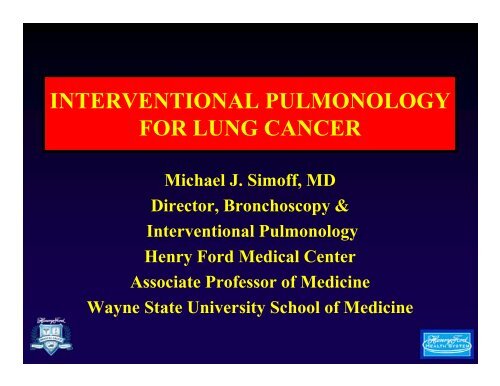Interventional Pulmonology 2012
Interventional Pulmonology 2012
Interventional Pulmonology 2012
- No tags were found...
Create successful ePaper yourself
Turn your PDF publications into a flip-book with our unique Google optimized e-Paper software.
INTERVENTIONAL PULMONOLOGYFOR LUNG CANCERMichael J. Simoff, MDDirector, Bronchoscopy &<strong>Interventional</strong> <strong>Pulmonology</strong>Henry Ford Medical CenterAssociate Professor of MedicineWayne State University School of Medicine
OBJECTIVES• Introduce <strong>Interventional</strong> <strong>Pulmonology</strong>• Review advances in diagnostic techniques• Discuss ablative technologies• Clinical applicability of <strong>Interventional</strong><strong>Pulmonology</strong> in the management ofobstructive lung disease• Future applications of technology
THE HUMAN LUNG• 22-24 generations• >100,000 bronchi,bronchioles• 2400 km (1500 miles)of airways• 300-500 million alveoli• 0.3mm in diameter• Surface area 70m2• Capillaries 992 km(616 miles) end to endDetroit to Key WestDetroit to New York CityMichael J. Simoff, M.D.
ElectrosurgeryMetal StentsRigid BronchoscopyExternal NavigationEBUS-TBNALaserArgon PlasmaCoagulationAutofluorescenceBrachytherapyTBNA<strong>Interventional</strong> <strong>Pulmonology</strong>PDTIndwelling CatheterHybrid StentsEndobronchial UltrasoundMicrodebriedementSilastic StentsCryotherapyMedical ThoracoscopyFibrin GlueBalloon DilitationGene Therapy
LUNG CANCER MORTALITY: WOMEN
INTERVENTIONAL PULMONOLOGYAND LUNG CANCER• Diagnosis• Staging• Airways obstruction• Stump dehiscence• Malignant pleuraleffusions• Tracheoesophagealfistulas• Therapy of earlyendobronchial disease
STAGING• The purpose of staging is todefine homogenous groupsof patients that are distinctfrom one another• Recommend therapy• Compare treatment results• Assess outcomes• Staging changes 2009 Rusch. J Thor Onc 2009
ADVANCED DIAGNOSTIC TECHNIQUES• Autofluorescence• Endobronchial Ultrasound• EBUS - TBNA• Transthoracic NeedleAspiration• Electromagnetic Navigation• CT Fluoroscopy GuidedBronchoscopic Biopsies• Confocal Microendoscopy• Endocytoscopy
WHITE LIGHT BRONCHOSCOPYSuperficial airway evaluation
AUTOFLUORESCENCESubmucosal evaluation
FLUOROPHORES / AUTOFLUORESCENCE• Blue light stimulates groundstate energy level• Excited state decay releasesenergy– 500 nm - Green (majority)– 650 nm - Red• Released light energy can bevisualized = Autofluorescence
NORMAL TRACHEAWhite LightAutofluorescence
MICROINVASIVE CARCINOMAWhite LightAutofluorescence
ENDOBRONCHIAL ULTRASOUNDBeyond the airway
CROSS SECTIONAL ANATOMY
EBUS - ANATOMY
EBUS - ANATOMYMichael J. Simoff, M.D.
• Airway invasion• Mediastinal structureinvasion• Transbronchialbiopsy• Ultrasound guidedTBNA• EBUS-TBNAEBUS – CLINICAL USES
ENDOBRONCHIAL ULTRASOUND• Evaluate up to 6 cmfrom airway• Identify LN to 5mm• Improve diagnosticaccuracy of TBNA• Assist in assessingT-stage of disease– Vessel invasion– MediastinalinvasionF Herth, MD. Heidelberg, Germany
AIRWAY ANATOMYEpithelium /Submucosa (0.05mm)Outer Submucosa (0.68mm)Inner bronchial cartilageBronchial cartilage (0.9mm)Outer bronchial cartilage/ AdventitiaMichael J. Simoff, M.D.CIBA Collection Vol 7,1980
EBUS and AIRWAYS
TUMOR INVASION OR IMPRESSION
TUMOR INVASION OR IMPRESSION
TRANSBRONCHIAL NEEDLEASPIRATION• Simple and safe• Lung cancer staging• Diagnostic tool:– Lymph nodes / Masses– Submucosa– Peripheral nodules
CURRENT USE OF TBNA• 11.8% routine use– 1991• 10% routine useby fellows– 1997• 28% routine use– 1999
EBUS GUIDED TBNA• Incorporate adirectionalultrasound probeinto a bronchoscope• Allow real-timevisualization ofsamplingBiopsy Needle
EBUS GUIDED TBNA
RADIOLOGY4R10RVessel involvement
EBUS-TBNA at HFH• Last 30 EBUS-TBNA cases– 76 samples taken– Target size 0.6-4.5cm– Locations• 2L, 4R, 4L, 7, 11L, 11R, 12R• Left hilar mass, R lung mass• Diagnosis achieved in 93.8% of cases (28/30)• Clinically relevant sample 92.9% (71/76)
SOLITARY PULMONARY NODULES
THE SOLITARY PULMONARY NODULEX-ray and Fluoro Invisible12mmAdenocarcinomaAdenocarcinoma
BRONCHOSCOPY FORSOLITARY PULMONARY NODULES• Transbronchial biopsieswith fluoroscopic guidance– > 2 cm• Yield 60%– < 2 cm• Yield
TRANSBRONCHIAL BIOPSY OF SPN• Peripheral lesions arebeyond bronchoscopicvisualization• Sampling techniquesare guided usingfluoroscopy• Lesions that are < 2 cmnot visible withfluoroscopyScopeBx ForcepsMichael J. Simoff, M.D.
FLUOROSCOPIC GUIDED TRANSBRONCIAL BIOPSYCourtesy Dr. D. Feller-Kopman
CT FLUOROSCOPYInvasive Poorly Differentiated Adenocarcinoma1 cm
EBUS AND PERIPHERAL LESIONS
PERIPHERALULTRASOUND
Electromagnetic Navigation
NAVIGATIONLocatable Guide
LOCATABLE GUIDE
Michael J. Simoff, M.D.
HFH EXPERIENCE: 6 MONTHSNInner 2/3 10TruePositiveDiagnosticYield>2 cm 4 100% 100%2 cm 4 50% 75%
BRONCHOSCOPY FORSOLITARY PULMONARY NODULES• Transbronchial biopsieswith fluoroscopic guidance– > 2 cm• Yield 60%– < 2 cm• Yield
THERAPEUTICINTERVENTIONAL PULMONOLOGYMalignant DiseaseBenign Conditions
THERAPEUTICS – BENIGN DISEASE• Tracheal Stenosis• Bronchostenosis• Tracheobronchomalacia• Broncholiths• Asthma• Emphysema• Radiation airway injury• Foreign body removal• Stump Dehiscence• Rare Diseases– Amyloidosis– Wegener’sGranulomatosis– RelapsingPolychondritis– Fibrosing Mediastinitis• Vascular, Bony, orthyroid airwayobstruction
THERAPEUTICS – MALIGNANT DISEASE• Endobronchialairway obstruction• Externalcompression• Tracheoesophagealfistula• Massive Hempotysis• Metastatic airwaysdisease
AIRWAY OBSTRUCTIONINTRINSIC EXTRINSIC MIXED
THERAPEUTIC TECHNIQUES• Rigid Bronchoscopy• Laser• Electrocautery• Argon PlasmaCoagulation• Cryotherapy• Photodynamic therapy• Microdebriedement
THERAPEUTIC TECHNIQUES• Silastic Stents• Metallic Stents• Hybrid Stents• Brachytherapy• Balloon Dilatation• Fibrin Glue
RIGID BRONCHOSCOPY• Airway control:– Ventilation– Bleeding• Faster• Applecoring• 8% of pulmonologistsChest 1991;100:1660
RIGID BRONCHOSCOPY
LASER• Light amplification bystimulated emission ofradiation– Nd:YAG– KTP• Tissue effects:– Thermal necrosis– Photocoagulation
LASER• 84-92% symptom palliation• Improved survival:– Control (n=25) Mortality• 4 month 76%• 7 month 100%– Laser treated (n=71)• 7 month 40%• 1 year 72%Brutinel et al. Chest 1987;91:159
IMPACT ON PATIENT ASSESSED QOL1210864FatigueDyspneaGlobal QOL20Baseline 7 Days 1 MonthEORTC QLQ-C30 SurveyMantovani et al. Clinical Lung Cancer. 2000; 1:277
ELECTROCAUTERY• Monopolar highfrequency alternatingcurrent• Tissue resistance is high• Energy converted toheat
ELECTROCAUTERY• Rigid or flexiblebronchoscope– Forceps– Cautery tip– Wire snare– Electrosurgicalscalpel
ARGON PLASMA COAGULATION• Ionized argon gas• Conducts electricalfield from electrodeto tissue• Coagulative necrosis• Superficial tissuedestruction
THERMAL ENERGY CAUTIONS• Appropriate eyeprotection• FiO2 less than .40• Equipment ignition• Airway rupture– Pneumothorax– TEF– Aortic or pulmonaryartery perforation
CRYOTHERAPY• Tissue destruction at-20 o to – 40 o C• Liquid nitrogen –196 o C• 1cm radius destruction• Cryonecrosis occursover 48 to 72 hours
MICRODEBRIDMENT• Newer technique• Precise resection ofendobronchial tumor/ granulation tissue• 1200 rpm• Active suctioningwith cutting tomaintain a clear fieldOscillating bladeSuctionLunn et al. Chest 2004:126;706-707s
PHOTODYNAMIC THERAPY24-36 hours48 hours
ENDOPROSTHESIS /BALLOON DILITATION• Silastic stents• Metal stents• Hybrid Stents• Balloon dilatation
STENTING• Exchange one chroniccondition for another• No perfect stent:– Migration– Erosion / rupture– Stent fracture– Bacterial overgrowth
SILASTIC STENTS• Dumon Stent• Hood Stent• MontgomeryT-Tube
SILASTIC STENTS• Removable• No growththrough stent• Cost• Requires rigidbronchoscopy
METALLIC STENTS• Ultraflex• Guidant• Aero
METALLIC STENTS• Favorable wall/innerdiameter ratio• Airway diameteradaptability• Absence of kinking• Flexible bronchoscopicinsertion
METAL STENTS:LIMITATIONS• Granulation tissue• Wall erosion• Migration• Fracture• Epithelialization– Stiff walls– Impaired mucousclearance
RUSCH-Y STENT• Hybrid– Silicone– Stainless steel struts• Thin posterior siliconemembrane• Dynamic design• Rigid bronchoscopy• 3 SizesMichael J. Simoff, M.D.
RUSCH-Y STENTPre-stent Proximal stent Distal stent
BALLOON DILATATION• Rigid bronchoscopy• Insert and insufflateballoon• Hold dilatation for 1-2minutes• Sequentially increaseballoon size
BRACHYTHERAPY• Localized radiationtherapy• Iridium-192• Low, intermediate,and high dose• HDR most effectivefor palliation (71-100%)Lo et al. Radiother Oncol 1995;35:193Seagren et al. Chest 1985;88:810
• Endobronchialadhesive• Used for “plugging”– Tracheo-esophagealfistula– Stump dehiscence– Broncho-pleuralfistula• TemporaryFIBRIN GLUE
• Pleural effusion:– 7-15% patients• Medicalthoracoscopy– Diagnostic– Therapeutic• Indwelling catheters– PleurX cathetersPLEURAL DISEASE
MEDICAL THORACOSCOPY• 67 Year old white male• Increasing shortness ofbreath• Pleural effusion diagnosed• Thoracentesis performedtwice– Exudative lymphocyticeffusion– Cytology negative
INDWELLING CATHETERS• Malignant effusionmanagement• Implantation withsubcutaneous tubingfor homemanagement• Effective nonirritantpleurodesisPleur-X Catheter
MULTIMODALITY THERAPYMost disordersrequire severalcomplimentaryprocedures
MULTIMODALITY THERAPY:ENDOBRONCHIAL TUMOR
MULTIMODALITY THERAPY:ENDOBRONCHIAL TUMOR1.9 mm
MULTIMODALITY THERAPY:TRACHEAL-ESOPHOGEAL FISTULA
THE FUTURE
THE FUTURE: ULTRASOUND
SOLITARY PULMONARY NODULES
THE FUTURE: ULTRASOUND
THE FUTURE:THE WAY WE SEE THINGS• Narrow Band Imaging• Confocalmicroendoscopy• Optical coherencetomography (OCT)• Endocytoscopy• Raman spectroscopy• X-ray photoelectronspectroscopy
NARROW BAND IMAGING• White light bronchoscopywith filters to only allowimaging of:– Blue 400-430 nm– Green 420-470 nm– Red 560-590 nm• Significant emphasis on415nm 465nm 540nmvascular changes
CONFOCAL MICROENDOSCOPY• Blue light excitationlaser (480nm)• Allows dynamic imaging– 0-250m depth– 5m resolution– 600m field of view• In-focus imaging ofbiological tissue
OPTICAL COHERENCE TOMOGRAPHY• Broadband near-infraredcoherent light• Reflected light combinedinto interference pattern• Computer signalacquisition and processing– Penetration 2-4mm– Resolution 10-20m• Need 1-2m to assesscellular structures(malignant vs. benign)Normal Retina
Tomophase Optical Tissue Analyzer Images1.2 mm2 mmCross-section of Chicken Trachea
OBJECTIVES• Introduce <strong>Interventional</strong> <strong>Pulmonology</strong>• Review advances in diagnostic techniques• Discuss ablative technologies• Clinical applicability of <strong>Interventional</strong><strong>Pulmonology</strong> in the management ofobstructive lung disease• Future applications of technology
ElectrosurgeryMetal StentsRigid BronchoscopyExternal NavigationEBUS-TBNALaserArgon PlasmaCoagulationAutofluorescenceBrachytherapyTBNA<strong>Interventional</strong> <strong>Pulmonology</strong>PDTPleurX CatheterHybrid StentsEndobronchial UltrasoundSilastic StentsCryotherapyMedical ThoracoscopyFibrin GlueBalloon DilitationGene Therapy
OBJECTIVES• Introduce <strong>Interventional</strong> <strong>Pulmonology</strong>• Review advances in diagnostic techniques• Discuss ablative technologies• Clinical applicability of <strong>Interventional</strong><strong>Pulmonology</strong> in the management ofobstructive lung disease• Future applications of technology
DIAGNOSTIC INTERVENTIONAL PULMONOLOGYBronchoscopyAutofluorescenceEBUS
OBJECTIVES• Introduce <strong>Interventional</strong> <strong>Pulmonology</strong>• Review advances in diagnostic techniques• Discuss ablative technologies• Clinical applicability of <strong>Interventional</strong><strong>Pulmonology</strong> in the management ofobstructive lung disease• Future applications of technology
LASER• Light amplification bystimulated emission ofradiation– Nd:YAG– KTP• Tissue effects:– Thermal necrosis– Photocoagulation Michael Unger, MD
OBJECTIVES• Introduce <strong>Interventional</strong> <strong>Pulmonology</strong>• Review advances in diagnostic techniques• Discuss ablative technologies• Clinical applicability of <strong>Interventional</strong><strong>Pulmonology</strong> in the management ofobstructive lung disease• Future applications of technology
BRONCHOSCOPIC TREATMENTSFOR EMPHYSEMA• Plugs or Blockers• Bronchial Valves• Airway bypass procedures(Stents through airway wall)• Sealants and biologics• Thermal Injury (Steam)• Mechanical collapse (Wireon spring)Michael J. Simoff, M.D.
OBJECTIVES• Introduce <strong>Interventional</strong> <strong>Pulmonology</strong>• Review advances in diagnostic techniques• Discuss ablative technologies• Clinical applicability of <strong>Interventional</strong><strong>Pulmonology</strong> in the management ofobstructive lung disease• Future applications of technology
FUTURE
FOLLOW-UP2003 Post-op 2004 20052006 2007 2009 2010 2011
CONTACT INFORMATIONMichael Simoff, MDAssociate Professor of MedicineDirector, Bronchoscopy and<strong>Interventional</strong> <strong>Pulmonology</strong>Henry Ford Hospital313-916-4406MSimoff1@hfhs.org
NAVIGATION
RADIOLOGY FOR BENIGN DISEASEInspiration58mm 2Expiration53mm 2Dynamic Expiration34mm 2
EBUS AND THE DIAGNOSIS OF CANCERAdenocarcinomaAtelectasisVS.Can we diagnose cancer?Courtesy of Felix Herth
EBUS AND THE DIAGNOSIS OF CANCERDistribution ofgreyscale signalsTuberculomaCourtesy of Felix Herth
EBUS AND THE DIAGNOSIS OF CANCERDistribution ofgreyscale signalsSquamous cell CarcinomaCourtesy of Felix Herth
GENE THERAPYDan Sterman, MD
GENE THERAPY AT HFH:A Novel Three-Pronged ApproachReplication-CompetentAdenovirus containingTwo Therapeutic GenesDouble Suicide Gene Therapy5-FC + GCVOncolytic Viral TherapyRadiotherapyTumor eradication
STAGING - TNMMountain, Dresler. Chest 1997;111:1718
CARCINOGENESISDysplasiaMutagenesis3-4 YearsCarcinoma in situ6 MonthsSaccomano et al.Cancer 1974
ANATOMIC CHANGES INPREINVASIVE LUNG CANCEREpitheliumAbnormalepithelium45 m70-116 mUpperSubmucosa700 mLowerSubmucosaCartilage1.2 mm
LASER ABLATION IMPACT ONQOL AND ECOG SCORES• 133 Laser Ablations• 89 patients• Standard Techniques:– Low power Photocoagulation (
BRACHYTHERAPY• 20-40 Gy delivered0.5-2 cm from beads• 2-3 treatments1 week apart• Complications:– Massivehemoptysis– Fistula formation
THE FUTURE:TO BIOPSY OR JUST LOOKOptical biopsies:– Opticalcoherencetomography– Confocalmicroendoscopy– Endocytoscopy
COPD• Emphysema, chronicbronchitis, obstructivebronchiolitis, asthma• Forth ranked cause ofdeath in the United States• >100,000 deaths per year• Substantial debility,physical impairment,reduced quality of lifeCourtesy Bronchus Tech
THE PROBLEMNormal LungEmphysema
ENDOBRONCHIAL LUNG VOLUMEREDUCTION• Reduce lung volumeby endoscopicallyoccluding bronchiand anatomically /physiologicallycollapsing the lung• Multiple techniqueshave been attempted
BRONCHOSCOPIC TREATMENTSFOR EMPHYSEMA• Plugs or Blockers• Bronchial Valves• Airway bypass procedures(Stents through airway wall)• Sealants and biologics• Thermal Injury (Steam)• Mechanical collapse (Wireon spring)Michael J. Simoff, M.D.
DOES IT WORK?1.41.210.80.60.40.200.71.28Before After 7days1.16After 1month1.08After 4months0.98After 6months98765432107.71Before After 7days5.27 5.39 5.16After 1monthAfter 4months5.51After 6monthsResidual volumeFEV 1330600500490520 5105704003002001000Before After 7daysAfter 1monthAfter 4monthsAfter 6monthsShuttle distance
EBLVRUnilateral Total Lobar Occlusion RUL
• Emphysus / PulmonXCLINCAL TRIALS– Study completed– Denied FDA approval– Purchased by PulmonX• Bronchus– Study complete– FDA review underway• Spiration– Recruitment began in mid 2007• Pneumonx– European preliminary trials ongoing• Aeri Seal– Phase 2 trial ongoing in EuropeMichael J. Simoff, M.D.
ASTHMA• 20 million asthma sufferers in US~14 million are adults• Lack of control is an enormous problem– Not optimally responsive or non-compliant– 10.4 million unscheduled physician officevisits– 1.8 million ER visits– 0.5 million hospitalizations– 5,000 deaths– Asthma-related healthcare costs = $14billion/yr
INFLAMMATORY CASCADE-switchB lymphocyteAllergicmediatorsAllergicInflammation:eosinophils andlymphocytesPlasmacellAllergensReleaseof IgEAsthmaExacerbationMast cellsBasophils
AIRWAY SMOOTH MUSCLEAirway Smooth MuscleNormal AirwayAsthmatic Airway
BRONCHIAL THERMOPLASTY• Bronchial thermoplastyreduces airway smoothmuscle throughcontrolled thermaltreatment to the airwaywall• Requires 3bronchoscopies• Bronchioles to 2 mm insize to be treated
Altered Airway Smooth Muscle12 Weeks Post-TreatmentUNTREATEDTREATEDDanek et al. J Appl Physiol 97: 1946-1953, 2004
BRONCHIAL THERMOPLASTY• Methacholinestimulatesbronchoconstrictionin most patients withasthma• Post treatmentminimal response tomethacholineCox et al. Eur Respir Journal; 24: 659-663, 2004
• The Alair Catheter is aflexible tube with anexpandable wire basketat the tip• The AlairRadiofrequencyController suppliesenergy via the AlairCatheter to heat theairway wallThe Alair ® System
AIR2 TrialObjective- To demonstrate the safety and effectivenessof the Alair System in a population ofsubjects with severe asthmaStudy Design- Randomized, double blind, sham-controlled- Minimum of 225 subjects; Maximum of 600(Bayesian Adaptive Statistics)- Multi-center, international study involvingup to 40 centers
Health Care Utilization For Respiratory SymptomsPost-Treatment Period (Events / Subject / Year 1 )1.00.832% DecreaseOver Sham84% DecreaseOver ShamEvents / Subject / Year0.60.40.70*0.4823% DecreaseOver Sham0.360.4373% DecreaseOver Sham0.20.00.28Michael J. Simoff, M.D.0.070.14Sham Alair Sham Alair Sham Alair Sham AlairSevereExacerbationsUnsched. OfficeVisits***ER Visits0.03Hospitalizations
CURRENT STATUS OF BRONCHIALTHERMOPLASTY IN THE USA• Bronchial thermoplasty has been approved bythe FDA (Federal Drug Administration) forclinical use in the USA• Many insurance carriers are not covering thecost of this procedure• Henry Ford Hospital is currently recruitingpatients for the AIR3 trialMichael J. Simoff, M.D.



